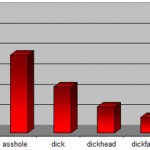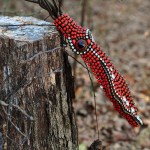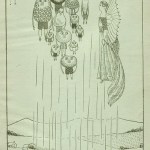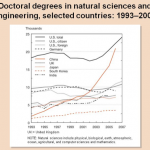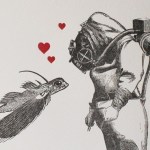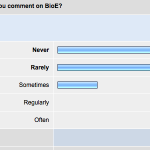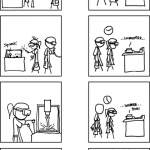
For minority undergraduates interested in careers in science writing:
The American Association for the Advancement of Science (AAAS) is proud to offer a summer internship program for minority students interested in journalism as a career and who want to learn about science writing. Experience what it's like to cover the scientific and technological issues that shape our global community. The Internship takes place at the Washington, D.C. headquarters of AAAS's Science magazine, the largest interdisciplinary journal in the world. The program is a paid, 10-week experience under the guidance of…
Did you hear about the scio10 civility meltdown? More about that in a minute. As you may have heard, it got a bit. . . uncivil. I wasn't there, so you, like me, will have to get your impression from this highly realistic renactment, created by an attendee who witnessed the confrontation between Nature's Henry Gee and our very own Zuska:
Whoa. Do I detect some tension? I'm reminded of the classic post 7 reasons the 21st century is making you miserable, according to David Wong:
Some of us remember having only three channels on TV. That's right. Three. We're talking about the '80s here. So…
Here's one for PZ: the lovely proprietress of Sea of Shoes shares two stunning, huge jeweled cephalopod pieces by Paris-based jewelry team Hanna Bernhard. These are some seriously impressive wearables.
Many more photos at Sea of Shoes, plus a short interview with the artists.
The famous apple-tree story, from a manuscript by one of Newton's friends:
"After dinner, the weather being warm, we went into the garden and drank tea, under the shade of some apple trees. [Newton] told me, he was just in the same situation, as when formerly, the notion of gravitation came into his mind. It was occasion'd by the fall of an apple, as he sat in contemplative mood.'Why should that apple always descend perpendicularly to the ground,' thought he to himself. 'Why should it not go sideways, or upwards? But constantly to the earth's centre? Assuredly, the reason is, that the earth…
Scibling Rebecca Skloot's new book, The Immortal Life of Henrietta Lacks, is coming out next month. To celebrate I thought I'd dredge one of my favorite pieces of hers out of the archive: "Fixing Nemo."
Dr. Helen Roberts was about to make the first incision in what should have been a standard surgery -- a quick in-and-out procedure -- when she froze. ''Bonnie,'' she said, turning to her anesthesiologist, ''is she breathing? I don't see her breathing.'' Roberts's eyes darted around the room. ''Grab the Doppler,'' she told her other assistant. ''I want to hear her heart. Bonnie, how's she doing…
Camille Allen's tiny baby sculptures have been all over the blogosphere. Contrary to popular belief, though, they're not made of marzipan (almond candy) or icing - they're polymer clay and mohair. So you're not supposed to eat them - thank heavens. Still amazing, though. (And a perfect counterpoint to the giant baby sculptures by Ron Mueck - or the giant baby I just posted by Parmigianino.)
Madonna and Child with Angels, AKA "Madonna with the Long Neck"
Parmigianino, c. 1534/40
From Edward Winkleman's blog, a good post about yet another art historian with convenient medical explanations for the artistic idiosyncrasies of the old masters. In addition to arguing that the Mona Lisa had high cholesterol, the historian has an even more timely link to current events:
Among his other findings are that two of the most iconic figures in Renaissance art had a rare condition that may also afflict Osama Bin Laden. One is the young man with a red cap and distinctly sardonic expression who…
A simply insane list of digital museums, libraries, and learning resources.
A Journey Round My Skull uncovered this DISTURBING children's book about anthropogenic talking fruit who appear to be suffering from a contagious respiratory disease.
I'm not sure why I find it so disturbing, but I do. It makes me feel like I'm on some sort of mind-altering substance. (I know many children's books can have that effect - and the Spongebob movie, too - but for some reason this fruit book is just creepier than usual).
Is anyone else reminded of Henry Darger's work?
Check out more illustrations at A Journey Round My Skull. You can use them to frighten vegetarian children.
A short (~4 minute) sweet overview of the political power of data visualization, by Tufte disciple Alex Lundry. He says so-called "dataviz" exists (you guessed it) "at the intersection of art and science." Quite right, sir!
You'll note Lundry makes use of the classic pirates-global warming relationship, Tufte's "pie charts suck" message, and so on. It's one of several good videos from a great event I really want to get to - igniteDC. I'd also like to mention that I'll be reviewing Connie Malamed's new book, Visual Language, which appears near the end of the video, in about a week or so, so…
Speaking of China, two graphs from the brand-spanking-new Science and Engineering Indicators 2010:
I detect some trends.
Back in October, there was an interesting article by Peter Hessler in the New Yorker about Chinese painters who make a living painting western scenes (Venice is popular) that they neither recognize nor are particularly interested in. Unfortunately the article is subscription-only, but if you have access it's worth a read. If not, you can check out a brief audio slideshow here.
The article raises some discomfiting questions about how America is perceived by the outside world, and how concepts we view as central to our culture are utterly meaningless when seen from outside. First, our small-…
Thanks to everyone who participated in the unscientific survey on commenting. The results are back, and I'd like to share them with you.
As many of you have noticed, we've been talking about comments a lot here lately, both at BioE and on Sb in general. There's also a big session on online civility coming up at SciOnline '10. So the main purpose behind the survey was to get you involved in that discussion.
I've brought the issues of uncivil and uninformed comments up in several posts, sometimes rather provocatively, but we already know that the majority of blog readers don't comment often,…
BldgBlog has a great post featuring Noah Sheldon's photographs of the decaying, abandoned Biosphere 2.
From BldgBlog:
"The structure was billed as the first large habitat for humans that would live and breathe on its own, as cut off from the earth as a spaceship," the New York Times wrote back in 1992, but the project was a near-instant failure.
Scientists ridiculed it. Members of the support team resigned, charging publicly that the enterprise was awash in deception. And even some crew members living under the glass domes, gaunt after considerable loss of weight, tempers flaring, this…
Light Writing Proposal, by Derick Childress. Via Good.
Congratulations, Derick and Emily.
It's like an episode of Mythbusters!
Adam: "Is it really true that if a windmill spins too fast, it disintegrates?"
Jamie: "Apparently, yes. Now we need to make a dummy out of A) a pig carcass or B) ballistic gel, and see what happens when he's standing under a disintegrating windmill."
From Sheril at the Intersection.
What can scientists do about Hollywood's ongoing inability to depict science in a realistic manner, as depicted by xkcd? If you're interested in this question (or still angry that Scully was somehow able to complete a Southern blot on trace alien DNA over her lunch hour), you may be interested in tomorrow's Armed with Science guests: blogger Jen Ouellette, who's heading up NAS' Science and Entertainment Exchange, and the executive producer of SyFy's EUREKA.
Jennifer Ouellette, director of the National Academy of Sciences' Science and Entertainment Exchange, and Jamie Paglia, co-creator and…
Attention all art/science web-collaborative types! Dave Ng has just formally announced the Phylomon Project. Here's the hook: a paper published in 2000 determined that an 8 year old could identify and characterize 120 different Pokemon characters, but when it comes to animals in their own backyard, kids have no clue.
There's nothing wrong with kids having rich fantasy worlds - far from it. But why not give them the chance to discover that real biology is also incredibly cool - not to mention complex, beautiful, and for many kids, right outside their back door? Maybe I'm showing my age, but…
Via somebody awesome. You can get a print of it at dresden codak.
